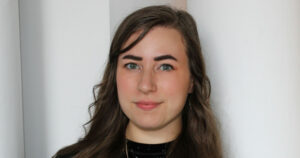Think of a well-known astronomer. Chances are you picture someone like Galileo, Sir Isaac Newton, or Johannes Kepler. In other words, a white man from hundreds of years ago.
Sparrow Roch would like to change that.
“There are many other people who have contributed to astronomy as a whole, and especially to the study of life in the universe,” Roch said. “We wanted to highlight that there are many people doing important work, but we might not discuss their contributions in our regular classrooms.”
Under the guidance of UWM Planetarium Director Dr. Jean Creighton, Roch, who uses they/them pronouns, developed a set of classroom resources highlighting the research of scientists – astrobiologists in particular – from diverse ethnicities and backgrounds. They presented their work at the Undergraduate Research Symposium.
Roch is a physics and computer science major who has been interested in astronomy since they were a child. “There’s this kind of excitement to being on the edge of knowledge that I think the study of space really brings,” they said.
Roch originally graduated from Brigham Young University with a degree in human development, but they kept feeling the pull toward science. So, they enrolled in college again, this time at UWM with the hope of studying under Jean Creighton, a personal role model of Roch’s. But, when Roch looked around, they noticed that astronomy, and physics in general, is something of a “boys’ club.”
“I do think it’s very discouraging to not see people in your classes that you’re learning about who you can relate to or who look like you,” Roch noted. “(Dr. Creighton) is very, very active in trying to increase diversity and have a more equitable environment for students on campus.”
So, when Creighton approached Roch and asked for help compiling resources on diversity in STEM fields, and particularly in astronomy, Roch jumped at the chance.
The numbers are sobering. According to Roch’s research,
• From 1994-2019, for any given academic year, the number of Hispanic people achieving their PhD in physics has only recently surpassed 40 people. For African Americans, no more than 20 have achieved a physics PhD in a year.
• Of nearly 60,000 physics PhDs awarded from 1972 through 2017, only 90 were awarded to African American women.
• From 2002 through 2012, despite making up nearly a third of the U.S. population, those from underrepresented minority groups made up only 3% of astronomy doctoral students.
• Black, Hispanic, and Native Americans comprise 27% of the US population but are less than 4% of the astronomy workforce.
Roch and Creighton hope that by increasing the visibility of Black, Hispanic, and other underrepresented minorities, they might help encourage those groups to pursue physics and astronomy.
To that end, Roch began compiling lists of astronomers – they narrowed her scope to astrobiologists in particular – in order to highlight their research.
There were challenges; Roch is not a biologist and had to enlist help to understand some of the research that was beyond their expertise. And, they added, because astrobiology is a relatively new field of research, there are fewer scientific papers published on the subject.
That’s not to mention the legwork.
“We looked at places like bioRxiv (a repository for biological sciences research) and arXiv (for astronomy research) for the astrobiology and related papers that were being posted there, and tried to search information about the authors,” Roch recalled. “I used some social media. Twitter has a pretty active astronomy scene. … Of course, we also had recommendations or word-of-mouth where we just asked people, who are the best astrobiologists we have to know about?”
Not only did Roch have to find these scientists, but they also had to summarize the researchers’ papers into twopage abstracts so that students using the materials they developed could understand and access the scientific papers.
The result is a compilation of resources that teachers and professors can use to create assignments for their students to learn about a diverse cohort of scientists.
“(We created) projects for some of these classes where the premise of the project was, we want to learn about present-day scientists and the contributions to their fields. Because many astronomers we learned about are people from long ago, there are still a lot of overlooked astronomers and physicists and engineers making advances,” Roch said. They and Creighton provided a suggestion list of scientists to report on.
For example, they included Moogega Cooper, a planetary protection engineer at NASA’s Jet Propulsion Laboratory who has also appeared on many television shows promoting space science. Or there’s Abel Méndez, an associate professor at the University of Puerto Rico at Arecibo and the director of the Planetary Habitability Laboratory.
Then, Roch and Creighton developed a list of questions for student to answer: What is the scientist’s background? What problems are they working to solve?
“We specifically asked, how do you connect with this person, and what do you have in common? We wanted to make these people more tangible,” Roch said. “(Then) I can see that wow, there’s lots of relatable things about many of the scientists, which for me, as someone who would like to be a scientist, is very encouraging. We are hoping for that same sort of outcome with these students.”
